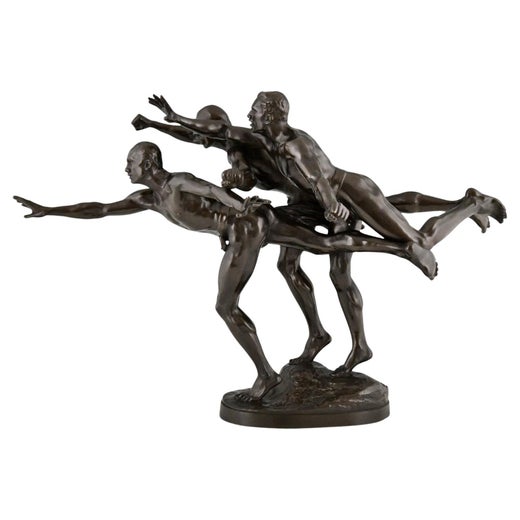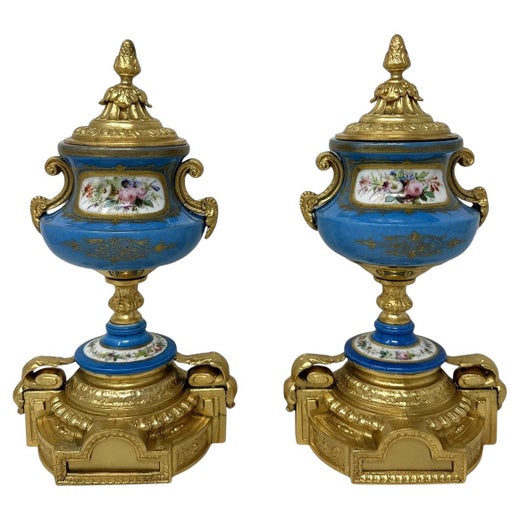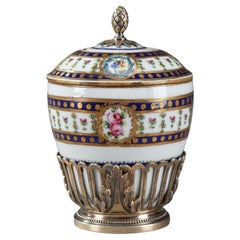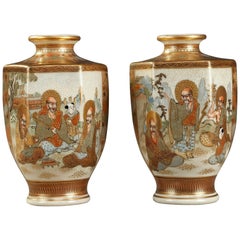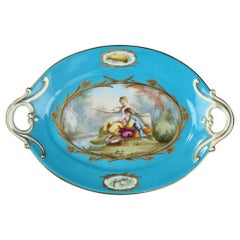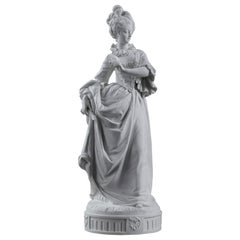20th Century Sèvres Porcelain Bisque Amour Boudeur by Alfred Boucher
About the Item
- Creator:Manufacture Nationale de Sèvres (Manufacturer),Alfred Boucher (Sculptor)
- Dimensions:Height: 17.72 in (45 cm)Width: 11.82 in (30 cm)Depth: 18.51 in (47 cm)
- Style:Art Nouveau (Of the Period)
- Materials and Techniques:
- Place of Origin:
- Period:
- Date of Manufacture:1914
- Condition:Wear consistent with age and use. In good overall condition. The biscuit porcelain with some small chips on the base.
- Seller Location:Paris, FR
- Reference Number:Seller: 25381stDibs: LU2065315898252
Alfred Boucher
The son of a farm worker, Alfred Boucher was born in 1850 in the French commune of Bouy-sur-Orvin and rose to prominence as a prolific, award-winning artist during the late 19th century, producing meticulously detailed sculptures for the likes of royalty and presidents.
When he was young, the Boucher family moved to Nogent-sur-Seine where his father secured gardening work for sculptor Joseph-Marius Ramus. Ramus, who worked in the neoclassical style, saw potential in Boucher. He invited him to work in his studio and helped him get a scholarship to Beaux-Arts de Paris when Boucher was 19 years old.
In Paris, Boucher studied under esteemed sculptors Augustin Dumont and Paul Dubois. He began to develop a unique style characterized by a sense of life, movement and symbolism. While Boucher is known as an academic sculptor, his work usually paid tribute to day laborers — an understandable endeavor given his father’s role as a farmhand.
As his profile grew, Boucher also secured commissions to create busts of prominent figures in the scientific community as well as politicians. The artist became friendly with Auguste Rodin — widely considered the father of modern sculpture — and mentored Laure Coutan and Camille Claudel. Later, in 1902, Boucher founded the low-cost studios La Ruche in Montparnasse to support young artists.
Boucher participated at his first salon in 1874, winning a bronze medal. He later lived in Italy and further honed his skills, and was awarded the Prix du Salon in 1881. He received the Grand Prix at the Exposition Universelle in Paris in 1900.
Boucher was promoted to Grand Officer in the Légion d'Honneur in 1925 and passed away in 1934.
Find original Alfred Boucher sculptures and other art on 1stDibs.
Manufacture Nationale de Sèvres
A maker of exemplary European ceramics for hundreds of years, Manufacture Nationale de Sèvres has produced porcelain of the highest quality since 1740.
The factory enjoyed royal patronage from its earliest days, and its most prominent patrons in the late 1700s — King Louis XV of France and his mistress, Madame de Pompadour — commissioned some of the period’s most elegant and striking pieces (only the truly wealthy could afford porcelain at this time). The company was originally established in Vincennes but was moved at the request of Madame de Pompadour, in 1756, to Sèvres, near Versailles, so that its operations would be closer to her château.
Sèvres became a mighty and much-revered factory working under a special grant from King Louis XV — the company’s owner as of 1759 and whose abundance of orders for special state gifts put financial strain on the company. Madame de Pompadour is said to have commissioned Sèvres to create an entire indoor garden of porcelain botanicals, for example.
While Sèvres gained a sterling reputation for its soft-paste porcelain wares, the company was late in entering into the production of hard-paste porcelain.
Hard-paste porcelain is the most common type of Chinese porcelain, then a widely exported and profitable product that was not made in Europe until the 18th century. The resources at Sèvres were largely relegated to meeting the demands of Louis XV, and secondly, it did not acquire the secret formula for hard-paste porcelain until 1761.
Until it obtained the coveted secrets behind hard-paste porcelain from a chemist named Pierre-Antoine Hannong — and, years later, gained access to the elusive raw materials to make hard-paste porcelain — Sèvres produced soft-paste porcelain for decades that was widely celebrated but is comparatively a far weaker type as opposed to the hard-paste productions of the company’s rival, Meissen, in Saxony, the first to produce true porcelain outside of Asia.
The artisans at Sèvres applied the rarest and most difficult-to-produce colors to their decorative objects and dinner services. One such color, the bright bleu de roi, became the manufacturer’s signature shade and is found on many of their objects. Sèvres also experimented with rarely glazed or unglazed works that bore no decoration at all — bisque porcelain, French for “biscuit,” refers to unadorned white porcelain sculptures made at Sèvres that resemble white marble after being kiln-fired.
Sèvres marks were applied over the glaze or rendered with cuts by a sharp tool — authentic Sèvres porcelain is most commonly marked with two interlaced Ls that are painted in blue and enclose a third letter. Painters and potters were tasked with affixing marks to record their role in the creation of a particular piece, and as a lot of these artisans’ names are recorded in archival factory materials — and there is also much to be learned at the Sèvres museum — it’s likely that you can accurately identify your Sèvres piece.
Find antique and vintage Manufacture Nationale de Sèvres vases, urns, sculptures and more on 1stDibs.
You May Also Like
Antique 19th Century French Figurative Sculptures
Porcelain
Antique 1890s French Louis XVI Figurative Sculptures
Porcelain
Antique Late 19th Century French Rococo Porcelain
Porcelain
Early 20th Century German Belle Époque Animal Sculptures
Porcelain
Vintage 1910s French Rococo Figurative Sculptures
Porcelain
20th Century German Rococo Revival Porcelain
Porcelain
Antique Mid-19th Century French Classical Roman Figurative Sculptures
Carrara Marble
Early 20th Century Czech Art Nouveau Figurative Sculptures
Porcelain
20th Century Spanish Porcelain
Porcelain
Antique Late 19th Century Unknown Victorian Busts
Porcelain
More From This Seller
View AllAntique 19th Century French Louis XVI Inkwells
Silver
Antique Early 19th Century Japanese Japonisme Porcelain
Porcelain
Antique 19th Century French Napoleon III Porcelain
Porcelain
Antique 19th Century French Louis XV Figurative Sculptures
Porcelain
Antique 1880s French Vases
Bronze
Early 20th Century French Louis XV Porcelain
Ormolu, Bronze
